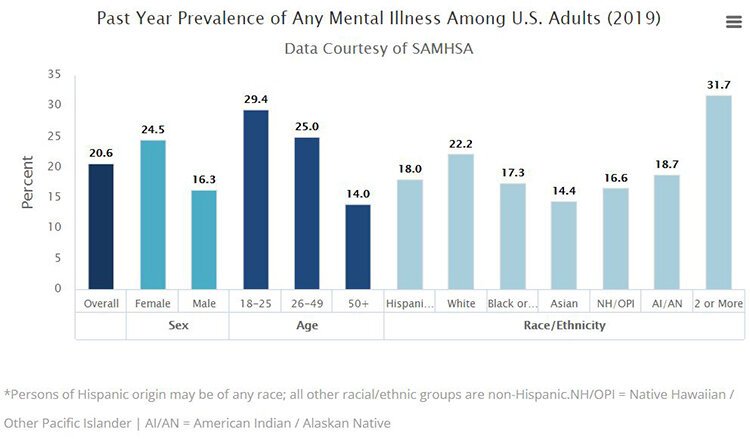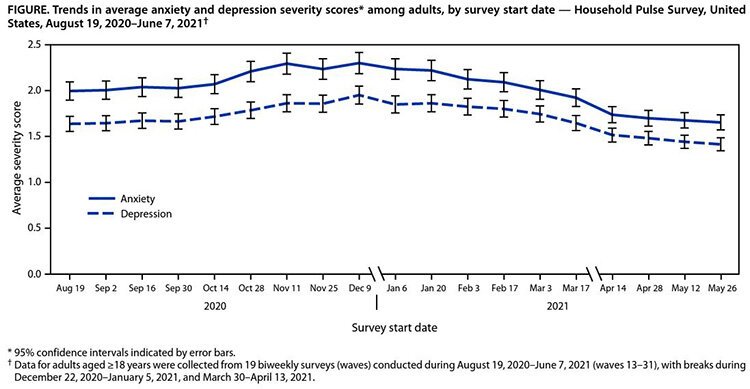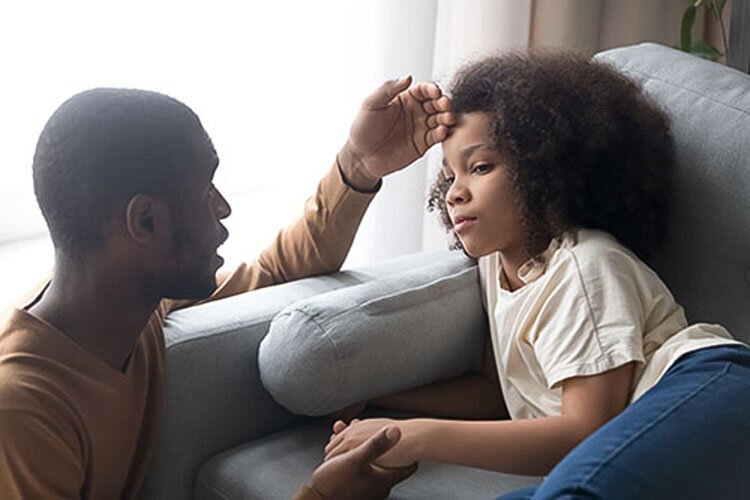The COVID-19 pandemic has had a widespread impact on the mental health of both adults and children. The resurgence of the Delta variant and ongoing mitigation measures—such as continued mask wearing and social distancing—are causing increased levels of social isolation, fear, depression, stress. and anxiety.
Changes in work, school and social routines, fear of contracting or spreading the virus, and the loss of loved ones to the virus have also taken a toll.
Even before the COVID-19 pandemic, the prevalence of mental health conditions was on the rise. According to the National Institute of Mental Health, nearly 52 million adults in the United States aged 18 and older experienced some form of mental illness in 2019.

Now, health experts are seeing an increased need for mental health services across all age groups—from young children to senior citizens—though each group faces its own set of challenges and setbacks.
Mental health challenges in the elderly
The pandemic significantly impacted both the physical and mental well-being of adults 65 years and older. Even in “normal times” the elderly face more social isolation, financial challenges, illness, grief, and loss than other age groups, all of which cause greater rates of anxiety and depression.


 Dr. Ardeshir Hashmi MD“The world shrinks for many older adults,” says Dr. Ardeshir Hashmi MD, Section Chief for Cleveland Clinic’s Center for Geriatric Medicine. “Many family members and friends pass away, and physical changes can make it more difficult to do the things they once enjoyed. There are not many life milestones ahead of them, so changing health is a big part of their lives and can be very scary.”
Dr. Ardeshir Hashmi MD“The world shrinks for many older adults,” says Dr. Ardeshir Hashmi MD, Section Chief for Cleveland Clinic’s Center for Geriatric Medicine. “Many family members and friends pass away, and physical changes can make it more difficult to do the things they once enjoyed. There are not many life milestones ahead of them, so changing health is a big part of their lives and can be very scary.”
Dr. Hashmi says mitigation measures to prevent the spread of COVID-19 have further compounded these mental health challenges “We are seeing significant mental health issues among the elderly—primarily related to social isolation including depression and anxiety, and the impact both have on brain health,” he says.
Social isolation can also increase the risk of cardiovascular, autoimmune, neurological, and other chronic health conditions. “It is kind of bidirectional,” explains Dr. Hashmi, “because the more stressed you are, the worse your cardiac health, brain health, and your physical health is going to be.”
Social isolation has always been a challenge for the older population and, while the pandemic has worsened things, it has also brought more attention to the mental health challenges of older adults. “This has been a pandemic within a pandemic all along,” says Dr. Hashmi. “The COVID-19 pandemic has put a spotlight firmly on this issue and the need to address the mental health epidemic among the elderly.”
Dr. Hashmi says the family caregiver can play an integral role in reducing their loved one’s social isolation. “First and foremost, maintain social connectivity with your loved one,” he says. “It can be as simple as a phone call, but the frequency, and not the duration, of those calls is the important thing.”


 We are seeing significant mental health issues among the elderly—primarily related to social isolation.Dr. Hashmi advises caregivers to look for other signs of concern. “Depression is sometimes very subtle and presents very uniquely in our patients,” he explains. “It could be lack of appetite or changes in appetite, decreased energy, changes in sleep, concentration, or psychomotor retardation—which is slowing of thought, speech, or physical mobility.”
We are seeing significant mental health issues among the elderly—primarily related to social isolation.Dr. Hashmi advises caregivers to look for other signs of concern. “Depression is sometimes very subtle and presents very uniquely in our patients,” he explains. “It could be lack of appetite or changes in appetite, decreased energy, changes in sleep, concentration, or psychomotor retardation—which is slowing of thought, speech, or physical mobility.”
Some older adults may also express feelings of guilt, hopelessness or that life is just not worth living anymore. “This is a big red flag,” Dr. Hashmi warns, “and should be cause for immediate concern.”
Caregivers can also help connect their loved ones to other resources. “There is a rampant lack of awareness of the community resources and services available right here in the Cleveland area,” says Dr. Hashmi. “Things such as getting groceries, preparing a meal, or help [with] getting ready for the day can help in a very practical and functional way.”
Virtual platforms for health and social services information and for entertainment purposes can also provide useful content. “Many of our seniors are on the other side of the digital divide,” says Dr. Hashmi. “Caregivers can be a navigator of technology so their loved one can benefit without grappling with the technical aspects of it.”



Raising awareness of these resources can help the elderly and their adult children know where to go for help. “Our job as health care professionals, with the help of family caregivers, is to connect seniors with those resources and support individuals in taking greater control of their own health.” says Dr. Hashmi. He recommends order a free copy of the Western Reserve Area Agency on Aging’s Older Adults…Resource Guide.
The impact on children’s mental health
Children and teens have also experienced anxiety and uncertainty during the ongoing COVID-19 pandemic. Even before the pandemic, mental health problems such as depression and anxiety were on the rise in children ages six to 17, according to the Centers for Disease Control and Prevention (CDC).
Just like adults, social isolation, school shutdowns, changes in daily routines, and loss associated with illness are all stressors that children are facing.


 Dr. Chivonna Childs PhD“Children are experiencing the same anxiety and depression as adults, but it may look a little different,” says Dr. Chivonna Childs PhD, Counseling Psychologist and Staff Psychologist at the Center for Behavioral Health at Cleveland Clinic. “They may be more irritable, cry a lot more, or worry more. They may show signs of sadness or changes in their eating and sleeping habits. Lack of attention and difficulty concentrating may be signs that they are having a rough time dealing with this.”
Dr. Chivonna Childs PhD“Children are experiencing the same anxiety and depression as adults, but it may look a little different,” says Dr. Chivonna Childs PhD, Counseling Psychologist and Staff Psychologist at the Center for Behavioral Health at Cleveland Clinic. “They may be more irritable, cry a lot more, or worry more. They may show signs of sadness or changes in their eating and sleeping habits. Lack of attention and difficulty concentrating may be signs that they are having a rough time dealing with this.”
Parents or caregivers need to help a child manage their anxiety and reassure them that it won’t always be this way, says Dr. Childs. “Validate your child’s feelings and encourage them to express and talk about their emotions,” she says. “If a child is struggling, reach out and find a good therapist who can offer support and help you navigate the situation.”
Dr. Childs says most school-age children and adolescents have read things online, seen something on television, or heard friends talking about the COVID-19 virus and may need help sorting through the misinformation.
“One of the best things we can do is to stay informed,” she says. “Get information from a reliable, scientific, medical source like the [CDC] or the World Health Organization (WHO), not from You Tube or Facebook.” Dr. Childs advises parents have frequent conversations with their child and be open and honest. “Ask them what they heard today and encourage them to ask questions,” she says. “Keep them informed and help them research the information for themselves.”
Additionally, Dr. Childs advises parents to be sure to speak to children at their own age levels. “If you have a three-year-old, speak to them like they are a three-year-old,” she says. “Teach them to bend their elbow, sneeze into their ‘trunk,’ use a tissue and throw the tissue right away.” The CDC offers a free COVID-19 Parental Resources Kit to help navigate these discussions.


 Parents or caregivers need to help a child manage their anxiety and reassure them that it won’t always be this way.“We need to teach our children to be resilient,” says Dr. Childs. “As parents we are their role models, so they are looking to us to tell them and show them what to do. First and foremost, we have to take care of ourselves. Remember to be in the present moment and enjoy what you have right now.”
Parents or caregivers need to help a child manage their anxiety and reassure them that it won’t always be this way.“We need to teach our children to be resilient,” says Dr. Childs. “As parents we are their role models, so they are looking to us to tell them and show them what to do. First and foremost, we have to take care of ourselves. Remember to be in the present moment and enjoy what you have right now.”
Knowledge is power. “The more we know, the more we feel like we are in control,” says Dr. Childs. “Limit the amount of news you take in but make sure you are informed enough to make the right choices for yourself and your family. If 2020 has taught us nothing else, it has taught us that we are resilient.”
This story is part of a five-part series on the Cleveland Clinic’s response to the COVID-19 pandemic and efforts toward recovery. To view the full series, click here.
